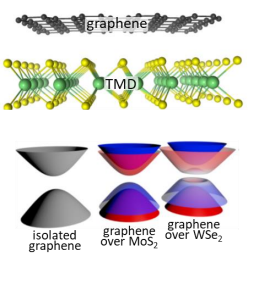Spintronique dans le graphène sur les dichalcogénures de métaux de transition : Simulations »
Publié le : 4 octobre 2024

Stage MASTER 2 – Durée 6 Mois ( début Février 2025)
Possibilité de thèse
Context :
In the context of spintronics, graphene is considered an ideal platform thanks to its very weak spin-orbit coupling (SOC), which allows spin scattering lengths of up to a few tens of micrometers [1]. For the same reason, however, spin manipulation is complicated. Transition metal dichalcogenides (TMDs), another class of two-dimensional materials, exhibit a considerable SOC due to the heavy metals they comprise. When graphene is over a TMD, a SOC is induced into graphene by proximity effect [2]. TMDs comprising a heavy metal element, such as WSe2, give rise to a pronounced SOC, which in turn results in a topological insulator and a spin quantum Hall effect.
[1] « Graphene spintronics: the European Flagship perspective », S. Roche et al., 2D Mater. 2, 030202 (2015)
[2] “Trivial and inverted Dirac bands and the emergence of quantum spin Hall states in graphene on transition-metal dichalcogenides”, M. Gmitra et al., Phys. Rev. B 93, 155104 (2016
Work program & Skills acquired during internship :
This internship is jointly proposed by CROMA (Centre for Radiofrequencies, Optic and Micro-nanoelectronics in the Alps) and SPINTEC (SPINtronique et TEchnologie des Composants) research laboratories affiliated with Univ. Grenoble Alpes, Grenoble INP-UGA, CEA and CNRS. The objective is to study, through simulations based on the density functional theory, the effect of a polycrystalline TMD on the band structure of the overlying graphene.
This is a common disorder in non-exfoliated TMDs, which warrants further study of how it affects the SOC induced in graphene. The different crystal orientations could lead to the formation of spin-polarized states in graphene at the grain boundaries, with important theoretical and application consequences. Thanks to the balance of theory and numerical computation that exists between our two labs, the intern student will develop important skills in the use of ab initio and tight-binding codes, thus enabling her or him to continue working in our labs with activities focused on magnetic or ferroelectric memories for low-power electronics and artificial intelligence.
CROMA
https://croma.grenoble-inp.fr
3, Parvis Louis Néel 17 avenue des Martyrs
SPINTEC
https://www.spintec.fr
38016 Grenoble 38054 Grenoble
Contacts:
• Alesssandro CRESTI alessandro.cresti@grenoble-inp.fr
• mair.chshiev@cea.fr
Requirement:
(i) understanding of quantum mechanics and solid state physics,
(ii) basic knowledge in computers with Linux operating system and/or basis in programming languages,
(iii) previous experience in density functional theory is a plus.
Requested background: Master 2
Duration: 6 months
Start period: February/ March 2025
Possibility of PhD thesis : YES



 Contactez-nous
Contactez-nous Plan d’accès
Plan d’accès









